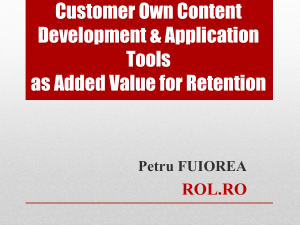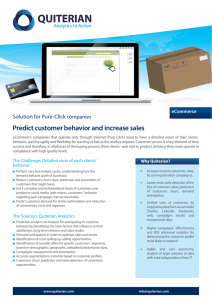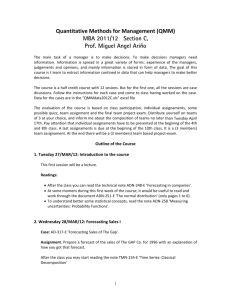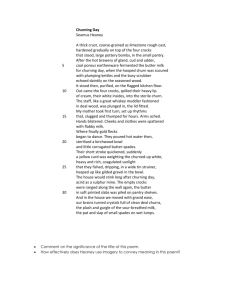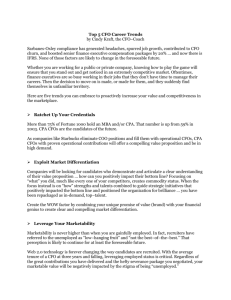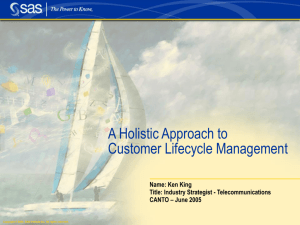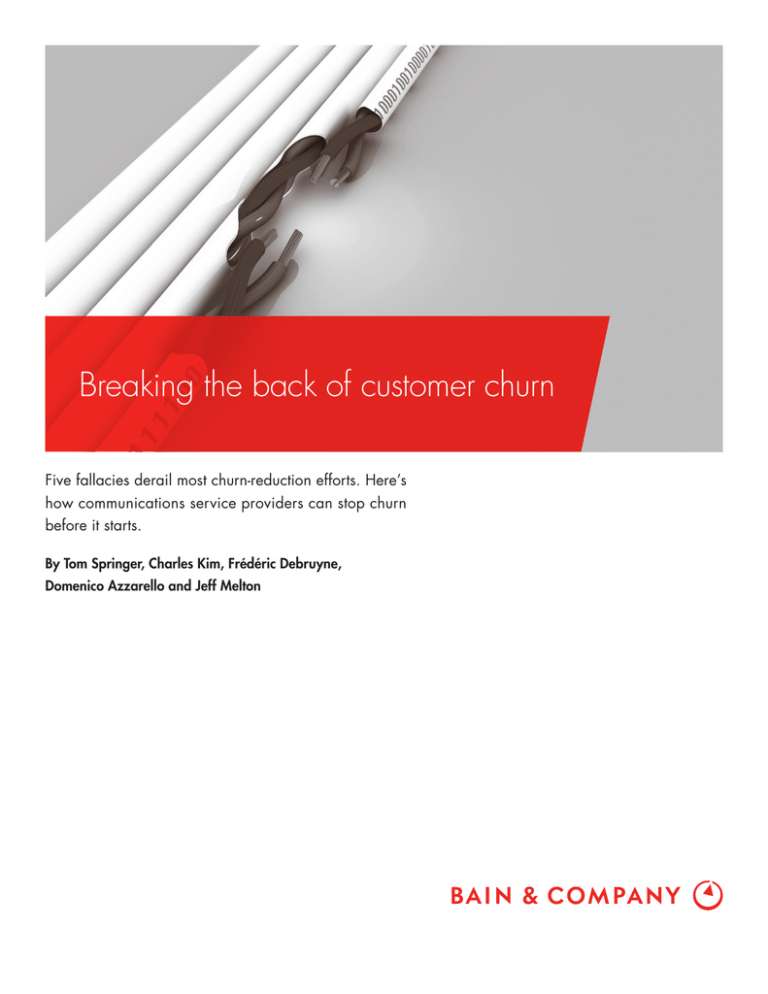
Breaking the back of customer churn
Five fallacies derail most churn-reduction efforts. Here’s
how communications service providers can stop churn
before it starts.
By Tom Springer, Charles Kim, Frédéric Debruyne,
Domenico Azzarello and Jeff Melton
Tom Springer is a leader in Bain & Company’s Customer Strategy & Marketing
practice and is based in Boston. Charles Kim is a co-leader in the firm’s
Telecommunications, Media & Technology practice in the Americas and is
based in New York. Frédéric Debruyne is a Brussels-based partner in the
firm’s Telecommunications practice. Domenico Azzarello is a Paris-based
partner in the Telecommunications practice. Jeff Melton leads Bain’s Asia-Pacific
Performance Improvement practice and is based in Melbourne.
Copyright © 2014 Bain & Company, Inc. All rights reserved.
Breaking the back of customer churn
Reducing customer departures and defections has
become a high priority for most communications service
providers as markets mature and competition intensifies. So why do high levels of customer churn persist?
Communications providers thrived in the
past as customer acquisition machines.
Now they have to invest in capabilities
that will retain and delight customers.
Service providers know that churn corrodes their business,
but many of them don’t truly understand how churn
works or what to do about it, because they’re often aiming at the wrong target. These firms thrived in the past
as customer acquisition machines, built to grow through
rapid penetration of the digital television, Internet and
voice products they introduced during the past decade.
Their cultures and capabilities haven’t adapted to the
new reality of greater choice for consumers, including
choice of satellite and over-the-top online video alternatives.
They still reward more for new installations than for growth
in the number of profitable subscriptions. They invest
more in advertising and marketing than in service technicians or in set-top box capabilities that would delight
or at least retain customers. And they don’t pursue the
rewards of customer loyalty as much as they hunt aggressively for new sales to replace departing customers.
As a result, service providers have made little progress
in reducing customer churn. Churn levels vary a bit by
provider and country of operation, but among wireline
providers, for instance, they tend to hover around 2% to
2.5% per month.
For a wireline company with 5 million customers, that
means an estimated 1.32 million people and $2 billion in
revenue walk out the door each year. Reducing churn by
50 basis points thus would be worth roughly $240 million
in lifetime value after 18 months and roughly $410 million
after 30 months. If one includes operating expenses
Figure 1: Churn results from the cumulative experience of many episodes
Circumstances that open the funnel, such as
poorly set expectations during the sales process
or a latent installation problem
Pre-churn
Root causes
Interactions that build frustration
Tipping point
Final trigger
One or more events that predispose a customer to churn
Event that triggers the decision to defect, such as a move within a service area,
a competitive marketing brochure or a recommendation from a friend
Churn
Post-churn
Interactions with the company that make customers more or less likely to return,
such as the equipment return process or marketing materials
Source: Bain & Company
1
Breaking the back of customer churn
that could be avoided, the value would reach roughly
$320 million and $490 million, respectively.
installation to spotty network performance to a faulty
bill. These customers have already been primed
to leave by the time an attractive offer arrives, so that
any change in their lives, such as moving to a new
house, can bring the decision to a head. The episodes
that condition a customer to dislike his or her provider
and the actual decision to leave can be years apart (see
Figure 1).
Adapting to the realities of churn
Communications service provider executives should take
a hard look at their own organization’s assumptions
and behaviors. Our experience working with service
providers globally suggests that five fallacies about
churn hinder breakout performance. Understanding
the real dynamics behind each of these fallacies will
allow executives to break the corrosive cycle of churn.
Treating only the last episode or two rarely leads to a complete solution that addresses the customer’s discontent.
For one US wireline provider, we convened focus groups
with customers who had recently departed, asking them
to write a brief story about their relationship with the
company. Each story recounted a series of bad episodes
over many years, such as error messages when trying
to watch a movie, call center representatives spelling
names wrong or debt collectors calling for a bill that
wasn’t owed.
Fallacy 1: One or two poor episodes cause churn.
Reality: Churn results from a series of episodes over time.
Remedy: Focus on the entire customer journey, not the
latest episode.
When we ask communications executives what causes
their customers to defect, they often point to the last
thing that happened before the customer left. Often,
that’s a competitor’s promotional offer. Competitive
offers do sometimes lure customers to switch, but typically after a long period of eroding trust that results
from a series of misadventures ranging from a poor
These episodes had built up misery and resentment in
customers’ minds. An initial irritation worsened until
a trigger event caused the customer to pull the plug. “I
finally had enough and switched,” wrote one departed
customer. “Even if [the company] pays me, I wouldn’t
return” (see Figure 2).
The five fallacies that derail churn-reduction efforts
1. One or two poor episodes cause churn.
2. Intervention at any point can save the day.
3. One silver bullet will stop churn.
4. Satisfying customers is good enough.
5. Success hinges on installing the right technology and processes.
2
Breaking the back of customer churn
Figure 2: Most customer problems can be spotted early on
Dominick’s story...
“The rep spelled my last
name wrong, which led
to a lot of hassle when I
needed support online
or on the phone.”
Quality issues: Error
messages, couldn’t
watch shows or movies.
Outages: Many occasions
where the cable would
be out altogether.
Onboarding
Performance (TV)
Year one
Year two
Equipment: Cable line
down in front yard.
Performance
Year three
Year four
Customer service
Interaction
“They would be short
and on occasion would
say, ‘You can access this
information online.’
Really? That would be
great—if I could get on
the Internet.”
Time
“When I would call, I
had to wait awhile to
reach someone because
the automated technical
support was useless.”
Called three times with
different work orders
before old equipment
was finally removed.
“Apparently the company
sent me to a debt collector
for a balance that I do not
owe… I never once
received a bill for this
supposed balance.”
Customer service
Payment
Year five
After departure
External factor
Interaction
Rude, unhelpful call
center.
“I finally had enough
and switched to a competitor. But the heartache that the company
brought me is ever
present.”
“This company will
never be in my home
again! My home-buying
decisions will ensure that
it is not an option!
Even if they paid me, I
wouldn’t return.”
Source: Bain & Company
Advanced analytics can further refine such interventions.
Sentiment analysis, for instance, can mine social media for
what people are saying about the company and its service
in online chat forums and social media platforms. People
posting about an outage in their neighborhood can help
companies anticipate a surge of calls, and criticism of
a particular service can serve as an early warning of
potential detractors.
Some companies will escalate service
a u t o matically when a negative event
occurs in order to resolve the issue
quickly before it builds resentment in
the customer.
Fallacy 2: Intervention at any point can save the day.
Reality: It’s more costly and less effective to intervene later.
To counteract churn journeys in progress, some companies experiment with event-triggered service escalation. For example, multiple trouble calls within a week
trigger an outbound service call from an elite troubleshooting unit, which has the authority to schedule an
immediate service visit if the problem cannot be resolved quickly over the phone. Or negative feedback
from a high-value customer in a post-interaction survey triggers an immediate call from the relevant
supervisor, who can resolve outstanding issues and offer
compensation for poor service.
Remedy: Excel at a few interactions from the start in
order to build equity with the customer.
If episodes were unconnected in the customer’s mind,
he or she might well remain happy as long as a company
manages the last interaction well. In fact, consumer
attitudes take shape through a series of episodes,
and after a few negative ones it becomes increasingly
difficult and expensive to intervene successfully.
3
Breaking the back of customer churn
Yet that is exactly what most service providers try to
do. They make an offer of expanded services or lower
prices in an effort to “save” the customer at the moment
the customer is attempting to quit. These “bribes” sometimes can be effective in averting defection in the moment,
but they’re ineffective and costly over the longer term.
Dangling such carrots teaches customers to expect
incentives when they have other problems in the future,
and fails to address the problem that prompted the
customer call in the first place.
Verizon, for instance, has learned that the installation
of its FiOS package in the home is a moment of truth.
Instead of taking the standard approach of doing the
installation as fast as possible, Verizon overinvests.
Its well-trained, well-spoken staff often spend four to
six hours in a customer’s home, running through how
the system works and making sure that every application is functioning well. That makes the experience
memorable for the customer and also sets up Verizon
for fewer technical troubles later on.
Had the provider paid attention to the journey that ended
at the “save desk” and resolved earlier episodes in
a graceful way, it might truly have saved many of these
relationships. Fixing the problem early on, or taking
time to create a great initial experience, goes a long
way toward building equity with customers.
Fallacy 3: One silver bullet will stop churn.
Reality: Churn will not succumb to a single initiative,
because churn takes different paths and each path stems
from several root causes.
Remedy: Focus on the subset of root causes that have
the greatest effect.
To do that, leading companies identify and invest
in those few activities at the start that can delight customers and deposit goodwill in the equity bank.
Given that churn results from a chain of episodes, the chain
is only as strong as its weakest link. Fixing one link at
Figure 3: Sift customers’ verbatim feedback to precisely identify and attack root causes of churn
Price
Offerings
Onboarding
TV
Could not get picture
- Blank or frozen screen
- Specific channels didn’t work
Issues with image quality
- Fuzzy or pixilated image
- On-screen tiling
- Lines across screen
Issues with sound
- Volume too soft
- Sound lagged image
- Sound echoed
Other equipment or features not responsive
- DVR, on-demand, remote control,
channel guide
Customer
service
Performance
Billing
Internet
Phone line did not work
- Blank or frozen screen
- Specific channels didn’t work
Intermittent problems
- Some Web pages worked while others didn’t
Actual speed mismatched to my needs
- Slower than promised speed
- High speed causing other quality issues
- Speed is variable and inconsistent
Equipment or features not responsive
- Cloud, email, antivirus, router
Source: Bain & Company
4
External
factors
Phone
Could not get online
- Frequent or long outages
Payment
Issues with call quality
-
Dropped calls
Volume too loud or soft
Background noise, poor clarity
Echoes, voice lag
Breaking the back of customer churn
Figure 4: Looking at customer survey data by frequency and volume of issues shows where a company
can focus its initiatives
Root cause and tipping-point issues
for one wireline service provider
Trigger issues
100%
Other
80
60
On-screen tiling
DVR didn't work
Phone outage
Fuzzy or pixelated image
Speed slower than promised
Specific channels didn't work
40
Speed inconsistent
No channels worked
20
Could not get online
0
Performance
(43%)
Other
100%
Negative
interaction
with technician
Other
Other
Too few channels
Internet equipment not
technically advanced
Not enough HD channels
Don’t want contract
Specific channels
unavailable
Channels removed
Had to take
unwanted services
in bundle
Offerings
(22%)
Install
timing
Inconsistent
Equipment
charges
Bill information
Price increase
doesn’t
for unknown
explain
reason
Issue
changes
Too
not
resolved expenRep didn't
sive
seem to care
More
Failed
expensive
installation Billed for Took too
than
unordered much
competitor
products
time
Promotion
More expensive
expired
than agreed
Installation Billing Customer Price
(13%)
(9%) service (5%)
(8%)
Billing
Customer service
Performance
80
Other
Installation
60
40
Offerings
Too expensive
for usage
Too expensive
for budget
Promotion
expired
More expensive
than competitors
Move outside
service area
20
Move within
service area
Competitor
interaction
0
Column width weighted by combination of how many customer journeys cross that category and how many customers are on each journey
Source: Bain & Company
a time merely extends the time it takes to see results. Any
one of numerous problems can erode the customer’s
trust, and each problem may have several root causes.
what they are doing right and what they are doing
wrong in customer episodes. Verbatim customer
comments, when sifted by the latest text mining
tools, produce a catalog of defects by type and frequency ( see Figures 3 and 4 ). The picture will
change by city, by customer segment and over time.
So it’s critical to analyze the right groups of customers and to regularly refresh the data. The company can then take action to improve the experience, which helps to turn customers into promoters
who don’t want to leave for a competitor. In the
communications sector, companies have found that
improving their NPS relative to competitors correlates with reduced churn.
One initiative, in other words, won’t stop churn.
Instead, it’s more effective to attack on multiple fronts,
after teasing out the root causes of a problem. This starts
by soliciting customers’ feedback about all of the important
episodes they experience. Companies that use the Net
Promoter SystemSM, for instance, regularly ask customers
one question right after an interaction: “On a zero-to-10
scale, how likely is it that you would recommend this
company to a friend or colleague?” The companies sort
their customers into promoters (9s and 10s), passives
(7s and 8s) and detractors (zeros through 6s). The
Net Promoter ScoreSM (NPS®) is the percentage of promoters minus the percentage of detractors.
For example, At Bat, an application of Major League
Baseball, asks the customer at the end of a game
about the quality of the video stream. Such usagerelated sources of customer feedback can be matched
against technical metrics to help the provider modulate the experience in real time.
Through a series of follow-up questions, Net Promoter®
companies use customer feedback to quickly identify
5
Breaking the back of customer churn
there’s no systemic problem as long as the company
doesn’t do anything to annoy customers.
In the communications sector, companies
have found that improving their NPS relative
to competitors correlates with reduced churn.
That neutral position, however, does nothing to excite
the customer or build a store of goodwill. It’s no surprise,
then, that many customers who defect were previously
categorized as satisfied.
And the bar for satisfaction is relatively low. Fixing
service defects might satisfy the customer yet still not
manage to engender active advocacy. To achieve that level
of engagement, companies must also emphasize “wow”
moments that delight customers, especially highvalue customers. Raving fans will forgive a mistake by
their provider, as long as it’s a blip in a steady stream
of positive episodes.
The list of potential root causes—product performance,
installation, billing and so on—looks largely the same
across wireline companies, geographic markets and
even customer segments. But the importance of each
root cause can vary widely across different providers,
within a provider’s regions and products, and within
churn journeys.
One provider we worked with had been focusing its
churn-reduction efforts on back-end saves and price
concessions. After it started to solicit customer feedback
and do root cause analysis, the provider uncovered major
issues with product performance, which then could be
traced to a lack of investment in the network over the
previous few years. Using that information, the company
then doubled down on investing in repair and maintenance of its physical plant (see Figure 5).
For each moment of truth, it’s critical to take the customer’s point of view. In a fiber-optic installation, for
instance, the field technician can do everything by the
book, but if after his departure the customer is not able
to receive email, that will cause major frustration requiring
an expensive follow-up call. Taking a customer-centered
view, the field technician would sit with the customer
to walk through common email and other applications,
making sure they’re working as promised.
But there was a wrinkle: Churn was lower in certain
regions that had ignored the original directive from headquarters to cease investing in the network. In those
regions, upon further investigation, the root causes of
churn turned out to be pricing, channel bundles that
customers did not want and faulty installation.
Fallacy 5: Success hinges on installing the right technology and processes.
Fallacy 4: Satisfying customers is good enough.
Reality: Having the right technology, processes and
policies remains important, but great service also
requires employees with a customer-centered mindset and the latitude to act.
Reality: Customers who call themselves satisfied may be
passive and easily wooed by competitors.
Remedy: Give employees the tools and incentives they
need to rapidly address customer feedback.
Remedy: Earn customers’ active advocacy by delighting
them at key moments.
Service providers typically have robust systems that
can support efforts to reduce churn. But the best
infrastructure won’t be enough to stem the tide of customer defections. Companies need highly engaged
employee teams with the right data and feedback from
customers and a culture that focuses first on their
customers’ priorities. Successful companies also en-
For some service provider executives, the lack of churn
among most customers suggests that all is well and that
an unruly few cause most of the problems. If customer
satisfaction scores seem reasonable, the thinking goes,
6
Breaking the back of customer churn
Figure 5: Analysis of customer feedback caused a cable company to shift its investments
Before
After
• Focus on back-end “saves” and price concessions because
price and competitive offers appeared to cause churn
• Focus on improvements earlier in the funnel because price
doesn’t matter until the end of the journey
• Limit plant investment due to low ROI, tenuous connection
to churn
• Double down on plant investment because product
performance is a major source of annoyance
• Limit focus on the installation experience because it’s technically simple and furthest from moment of churn
• Installation is a moment of truth that can color the rest of a
customer’s experience
• Billing and customer service are the main pain points after
price and competition
• Focus on offerings, deemphasize billing and customer
service investments
Source: Bain & Company
which helped to sharply reduce the volume of calls and
increase customer loyalty scores.
courage cross-functional collaboration in order to
make structural improvements leading to a great
experience for customers.
For employees to effect change, it’s critical to build
customer feedback into daily operations and quickly
share the comments with the employees most responsible for the experience. That feedback forms the raw
material for a root cause analysis of problems that may
eventually cause churn.
For employees, rapid and frequent customer feedback forms the raw material
for a root cause analysis of both problems
and points of differentiation.
Such feedback helped a European telecommunications
provider reduce the excessive flow of customer inquiries
to its call center. Workshops with employees generated
many hypotheses about what prompted the calls, and
the company used customer feedback loops to winnow
the hypotheses to a handful that merited attention.
People on the front lines have a great influence over
the quality of the customer experience. So companies
that take a customer-centered view often change their
processes to give employees greater decision-making
autonomy. That does not mean anything goes; employees should rely on the systems and processes put
in place to improve customer advocacy. But within that
framework, individuals with clarity about their mis-
Among the causes of detraction were confusing bills
and product installation guides, limited call center hours
and long phone wait times. Armed with this solid data,
the company set about revising each of these areas,
7
Breaking the back of customer churn
sion who receive positive reinforcement for helping
customers will give companies their discretionary effort.
Most customers will tolerate mistakes if
they perceive the company responds in
good faith.
How leaders can make a difference
We’ve noted the importance of frontline employees
in bringing loyalty to life. Leaders up and down the
spine of the organization play important roles as well.
Most customers have resilience. They’ll tolerate mistakes if they perceive the company corrects its mistakes
in good faith. And they’re willing to give their advocacy
to companies that win them over early on and then resolve
the inevitable problems with grace. For communications
service providers, improving the experience of using
products and getting service will be far more effective
than bribing unhappy customers to stay.
At many customer-centered companies, the CEO
and COO make earning customer loyalty one of their
top three priorities. They show employees how “we
put the customer first” means moving beyond words
to actually behaving in different ways. They serve as
role models through their own actions, keeping the
senior team on board with the goals of reducing
churn and earning loyalty. They also break through
functional turf to insist on collaboration among different
departments and business units, to advance the common cause.
Other executives can advance churn-reduction efforts
by building a strong business case for investments
that will convince CFOs of the attractive returns. In
call centers, for instance, a company could estimate
the financial impacts of switching from incentives that
reward solely for average handle time to those that factor in first-time-right resolution. Or it could show how
selectively launching a truck roll avoids more customer calls in the future and thus costs less than a policy of avoiding truck rolls.
The supervisor’s role primarily involves reorienting
teams around closed-loop feedback from customers.
Supervisors and their team members need to flag
problems that create resentment among customers,
like a punitive fee, and bring the problems to the attention of people with authority to make a change.
Net Promoter® and NPS® are registered trademarks of Bain & Company, Inc., Fred Reichheld and Satmetrix Systems, Inc.
Net Promoter SystemSM and Net Promoter ScoreSM are trademarks of Bain & Company, Inc., Fred Reichheld and Satmetrix Systems, Inc.
8
Shared Ambition, True Results
Bain & Company is the management consulting firm that the world’s business leaders come
to when they want results.
Bain advises clients on strategy, operations, technology, organization, private equity and mergers and acquisitions.
We develop practical, customized insights that clients act on and transfer skills that make change stick. Founded
in 1973, Bain has 50 offices in 32 countries, and our deep expertise and client roster cross every industry and
economic sector. Our clients have outperformed the stock market 4 to 1.
What sets us apart
We believe a consulting firm should be more than an adviser. So we put ourselves in our clients’ shoes, selling
outcomes, not projects. We align our incentives with our clients’ by linking our fees to their results and collaborate
to unlock the full potential of their business. Our Results Delivery® process builds our clients’ capabilities, and
our True North values mean we do the right thing for our clients, people and communities—always.
Key contacts for Bain & Company’s churn-reduction work:
Americas: Tom Springer in Boston (tom.springer@bain.com)
Charles Kim in New York (charles.kim@bain.com)
Asia-Pacific:
Jeff Melton in Melbourne (jeff.melton@bain.com)
Europe, Middle
East and Africa: Frédéric Debruyne in Brussels (frederic.debruyne@bain.com)
Domenico Azzarello in Paris (domenico.azzarello@bain.com)
For more information, visit www.bain.com



